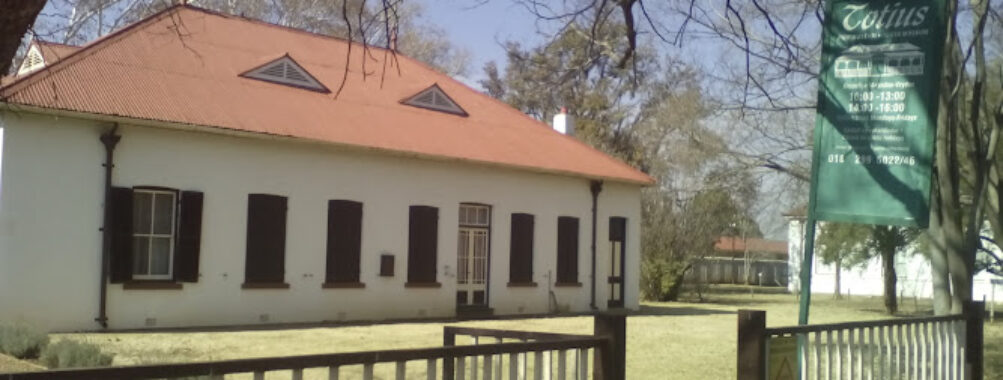
Totius House Museum
“`html
Table of Contents
Description
The Totius House Museum is one of those places that feels less like a stiff museum and more like stepping into somebody’s living memory. It was once the home of the well-known Afrikaans poet and Bible translator, Totius (J.D. du Toit), and today it’s preserved as both a historical site and a cultural treasure. Walking through the rooms, you don’t just see old furniture and books—you feel the quiet weight of history, the kind that makes you pause for a second before moving on. It’s a small museum compared to the big city institutions, but that’s part of its charm. There’s intimacy here, the kind of atmosphere where you can almost imagine Totius sitting at his desk, scribbling down lines of verse by lamplight.
The house is well-kept and accessible, with thoughtful touches that make it welcoming to families, older visitors, and even those who might just be casually curious about South African literature and heritage. It’s not flashy, and it doesn’t try to be. Instead, it offers authenticity—something I personally value when traveling. You won’t find a café or restaurant attached, so don’t come hungry, but you will find a place that rewards slow wandering and quiet reflection. For kids, it’s surprisingly engaging; the guides are usually open to questions, and the space itself is compact enough that they won’t get bored or overwhelmed.
What stood out to me the most was the balance between the personal and the historical. It’s not just about Totius the poet, but about the era he lived in, the struggles and ideals of his time, and the way those shaped South African culture. Some visitors might find it a bit too niche if they aren’t into literature or history, but for those who are—even just a little—it’s a rewarding stop. And honestly, even if you come in with zero knowledge of Totius, you’ll likely leave with a sense of appreciation for the man and his work.
Key Features
- Authentic period furnishings that preserve the original character of the home
- Collections of Totius’ personal belongings, manuscripts, and books
- Guided tours that offer context and stories about his life and influence
- Wheelchair accessible parking, making it easier for all visitors
- Family-friendly environment, suitable for children and school visits
- Quiet, contemplative atmosphere for those who enjoy slower-paced cultural experiences
Best Time to Visit
If you’re like me, you probably prefer visiting museums when they’re not packed with crowds. The Totius House Museum is rarely overrun, but weekdays in the late morning or early afternoon tend to be the calmest. That’s when you can really take your time without feeling rushed. The weather in South Africa can swing from blazing hot to chilly depending on the season, so I’d say spring and autumn are the sweet spots for combining a visit here with other outdoor activities in the area. Summer afternoons can get uncomfortably warm, and while the house itself is shaded, you’ll probably enjoy the experience more when the weather is mild.
There’s also something special about visiting on days when cultural or literary events are happening. Occasionally, the museum hosts talks or small gatherings, and those add a whole new layer to the experience. It feels less like a static museum and more like a living space still contributing to the community.
How to Get There
Reaching the Totius House Museum is straightforward if you’re already in the region. Most visitors arrive by car, and there’s parking available nearby, including accessible spots for those who need them. Public transportation options may be limited depending on where you’re coming from, so if you don’t have a car, arranging a taxi or rideshare is usually the easiest route.
I’ve found that the drive itself can be part of the fun—passing through smaller towns and open landscapes that give you a sense of South Africa beyond the usual tourist circuit. If you’re the type who likes to combine stops, the museum makes a nice addition to a day trip exploring other historical or cultural sites in the area. Just keep in mind there aren’t food services on-site, so plan your meals accordingly.
Tips for Visiting
Here’s the thing: the Totius House Museum isn’t the kind of place you rush through. Give yourself at least an hour, maybe more if you’re the type who likes to linger over old books or chat with the guides. They’re usually full of stories that you won’t find on the display cards, and honestly, that’s where the real magic lies.
Bring a bottle of water, especially if you’re visiting in the warmer months, since you won’t find a café here. If you’re traveling with kids, prepare them ahead of time by telling them a little about who Totius was—it makes the visit more meaningful, and they’ll be more engaged. And if you’re someone who likes to take photos, be respectful; this is a historic home, not just a backdrop for Instagram.
One last tip from me: don’t skip the small details. Look at the handwriting in his manuscripts, the wear on the furniture, the little imperfections that remind you this was once a lived-in home. Those are the moments that stick with you long after you’ve left. And if you’re like me, you might just find yourself inspired to pick up a book of poetry afterward, even if you haven’t read one since school.
“`
Location
Places to Stay Near Totius House Museum
Find and Book a Tour
Explore More Travel Guides
No reviews found! Be the first to review!